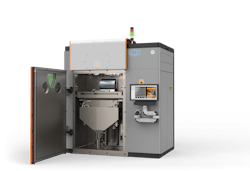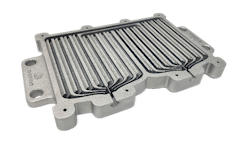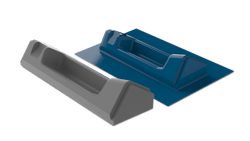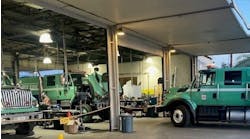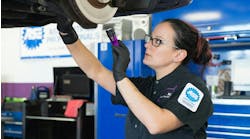How 3D printing can reduce parts shortages, drive sustainability in commercial vehicle industry
Globally, commercial and passenger transportation such as truck, bus, and rail have fallen victim to a deep slump due to reduced demand, labor shortages, and supply chain delays. But with advances in 3D printing, known industrially as additive manufacturing, it’s possible that commercial vehicle OEMs may not only streamline their processes to make both plastic and metal parts, such as heat exchangers or manifolds, but also decrease waste and development costs.
Vehicle parts can also be more thoughtfully designed, becoming lighter yet stronger because the parts geometries are not constrained by conventional manufacturing techniques. As the technology advances, it may soon be possible for a repair shop to simply order needed parts from a local contract additive manufacturer, who would only need the digital file to reconstruct a perfect facsimile. This would alleviate pressure on the supply chain and how much inventory distributors and shops need to keep on hand, freeing up capital.
What is additive manufacturing and why is it needed?
First, it’s important to know that additive manufacturing is a process by which a customizable digital design creates a product by laying down material layer by layer. This method adds increased customization in product configurations, a tactic many manufacturers have begun to implement to maintain their competitive advantage—particularly as inflation rises along with the cost of fuel to deliver new parts.
Those pressures, added to pandemic-related closures to and unprecedented backlogs (which themselves cause shortages in qualified maintenance technicians and parts), have made agile production and flexible manufacturing all the more necessary.
Based on evidence, additive manufacturing can be the tool to help address these shortcomings in the transportation industry, and increase production speed and component availability for critical parts, bolstering not only OEM productivity and inventory, but also by saving on wasted materials.
And by facilitating rapid innovation and reducing parts count simplifying logistics, speed to market has been shown to accelerate by 300%, while reducing inventory levels by 90%. This results in reduced risk for delays, simplified assembly operations, and reduced labor.
Additionally, with monolithic parts enabled by AM, product quality and reliability is improved, reducing the need for service support and the number of replacement parts. With the need for less inventory on hand for replacements, there is also a reduced need to dispose of discontinued stock parts at the time of product obsolescence.
Additive manufacturing also enables environmental sustainability via the production of parts, manufacturing aids, and tooling that requires less material and overall waste. Being able to produce parts and production tooling on-demand versus stocking them on shelves saves warehouse space while also eliminating the need to store costly inventory to support discontinued products. Finally, because AM provides design freedom to create parts not possible to produce with traditional manufacturing technologies, it offers engineers a path to design for the application versus designing for the manufacturing capability, thus enabling them to develop more energy-efficient products. Even more so, additive manufacturing streamlines a manufacturer’s business processes in several ways.
Production parts without tooling: Additive manufacturing is a process that inherently eliminates a major artifact in the production process – the tooling. The ability to directly produce a component from its digital representation not only makes the process more efficient but allows for the decentralization of the business model, quick adaption, and delivery for the customer experience, as well as achieving this with less manufacturing overhead and waste.
Digital inventory management: Thanks to the accessibility of digital inventories, design owners can now securely encrypt and distribute information globally. This allows them to control how many physical parts will be produced and guarantee quality while remote users or manufacturers can print them on demand without needing to ship, insure, store or maintain inventory. All of these factors allow for increased adaptability while cutting costs typically associated with CV manufacturing.
Rapid production tooling: Additive manufacturing technology is growing in productivity and build sizes, yet some critical parts still cannot be produced using current AM printers. Many parts (e.g., large metal castings, external body parts, large interior panels) also cannot be produced as efficiently as desired for end-use consumption and thus need to be manufactured conventionally. But in these cases, AM can still streamline the manufacturing process for parts it can’t yet produce by creating rapid low-mid volume molds and casting patterns, either sacrificial or re-usable, with the advantage of maintaining them as digital inventory tools and eliminating the need for environmentally controlled storage spaces for years.
Shifting Transportation Innovation to Full Throttle with AM
Companies with a solid long-term vision for sustainability endeavor to operate in a way that fosters economic growth, solves social challenges, and helps the planet by using renewable resources and eliminating waste. Leading transportation manufacturers and direct suppliers are realizing success by incorporating additive manufacturing into their production workflows. For those considering this journey, understanding initial capital investment levels, the right technology that aligns with the business need, and requirements for technical training can all seem daunting. This is where engaging a strategic partner can go a long way in providing technical assistance and end-to-end solutions that not only help execute the adoption of AM but also realize maximum benefits for their business. With the right partner and the right solution, I believe there is a tremendous opportunity for manufacturers and suppliers of all sizes to accelerate both their innovation and competitive position with the power of additive manufacturing.
Jaime Garcia is 3D Systems' Solutions Manager for Commercial and Public Transportation, 3D Systems.

